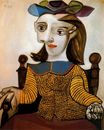©Пабло Пикассо - Три головы ягненка 1939
 |
 |
 |
 |
 |
 |
 |

Три головы ягненка 1939
65x89см холст/масло
Museo Nacional Centro de Arte Reina Sofía
The image is only being used for informational and educational purposes
<< Previous G a l l e r y Next >>
From Museo Nacional Centro de Arte Reina Sofía:
In spring 1938, once the Guernica cycle had been completed, Pablo Picasso periodically turned to the theme of vanitas, a motif he would work on until the mid-1950s. While in the mural Guernica the allusion to death was understood allegorically, in this series of still lifes the subject uses the traditional vanitas model, even using the iconography associated with the genre. Sheep heads, bulls’ skulls, rams’ skulls and human skulls all form part of the imagery, which links Picasso closely to the Spanish Golden Age, and very specifically with the works of Goya. This connection with the most fundamental Spanish plastic heritage is evident in the painting Trois têtes de mouton (Three Lamb's Heads), in which Picasso testifies to his Spanishness while uniting the cultural baggage from the past with the most important achievements of modernity.
The relationship this kind of work has to specific death-related events close to the artist explains the drama that runs through Picasso’s work in a period scarred by wars. As in many other aspects of his output, with these vanitas Picasso had enormous influence on the work of his contemporaries, including, for example, Luis Fernández.